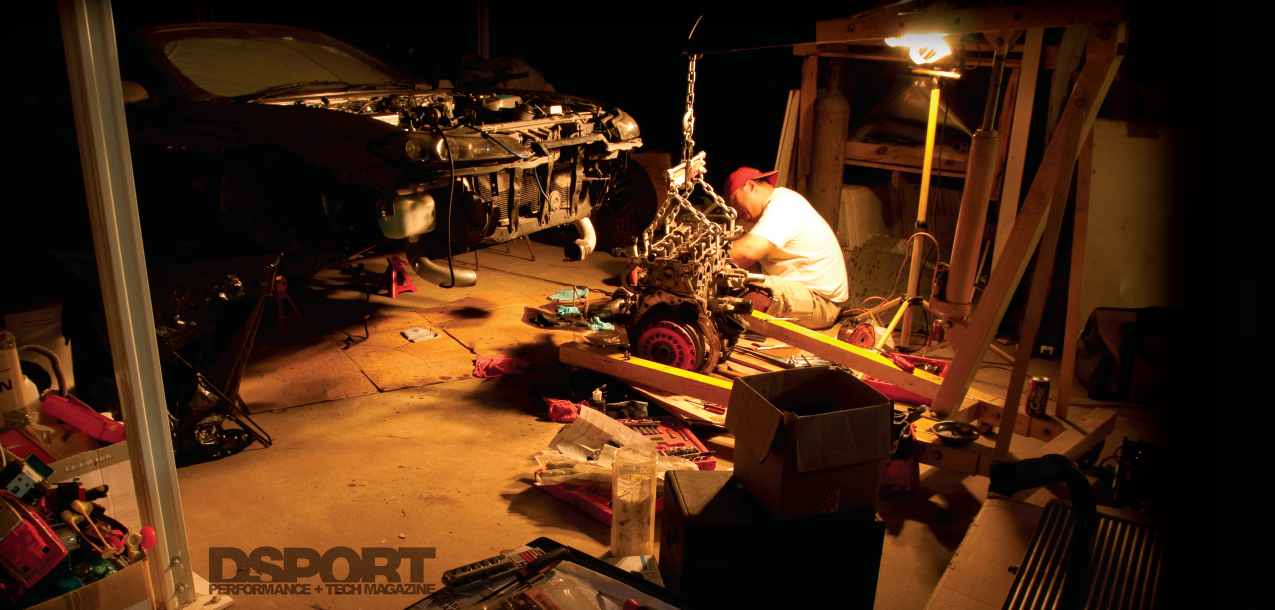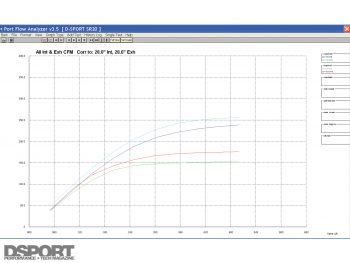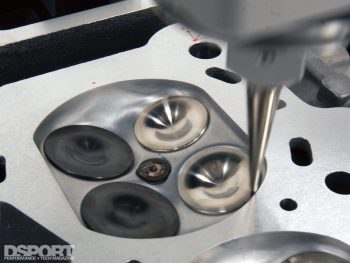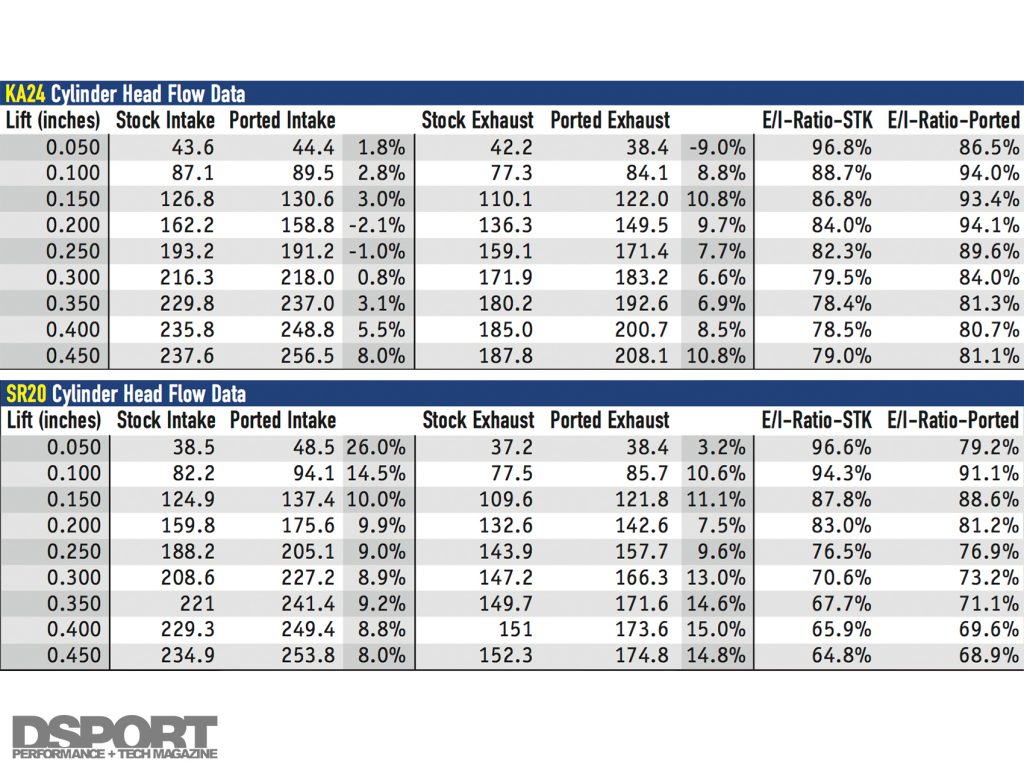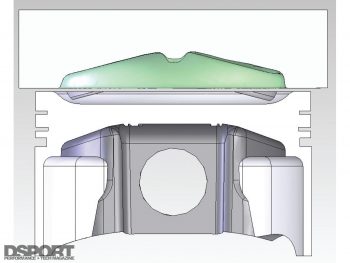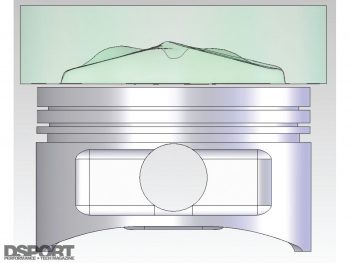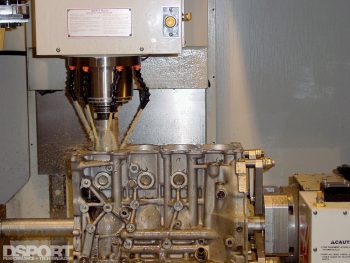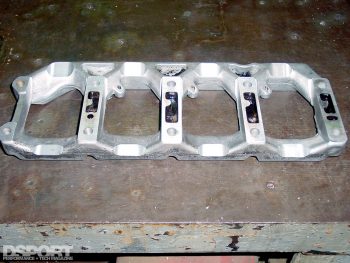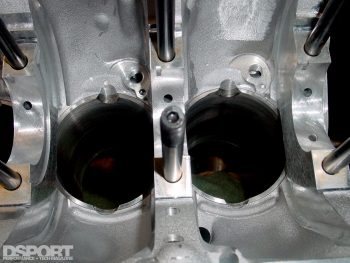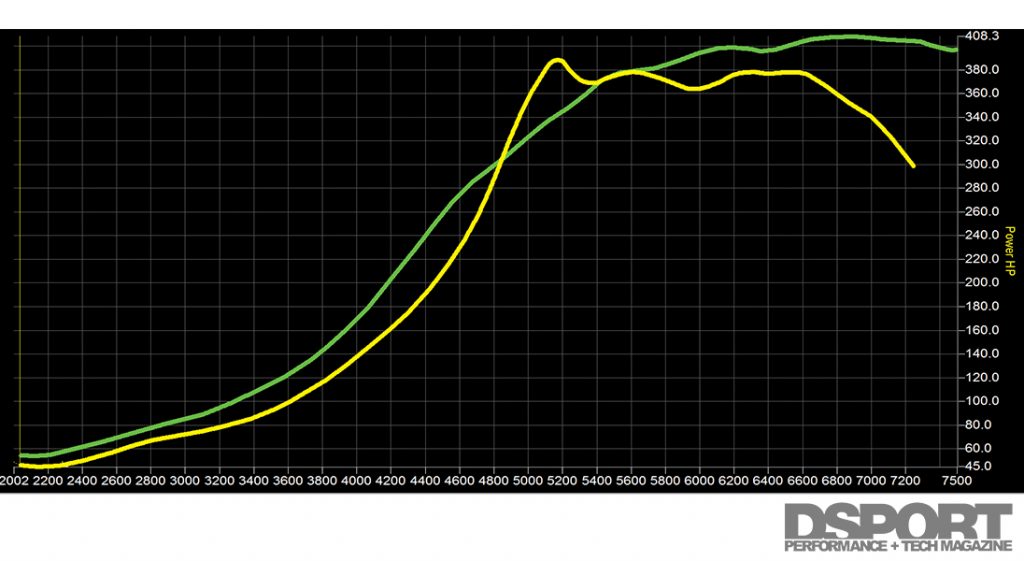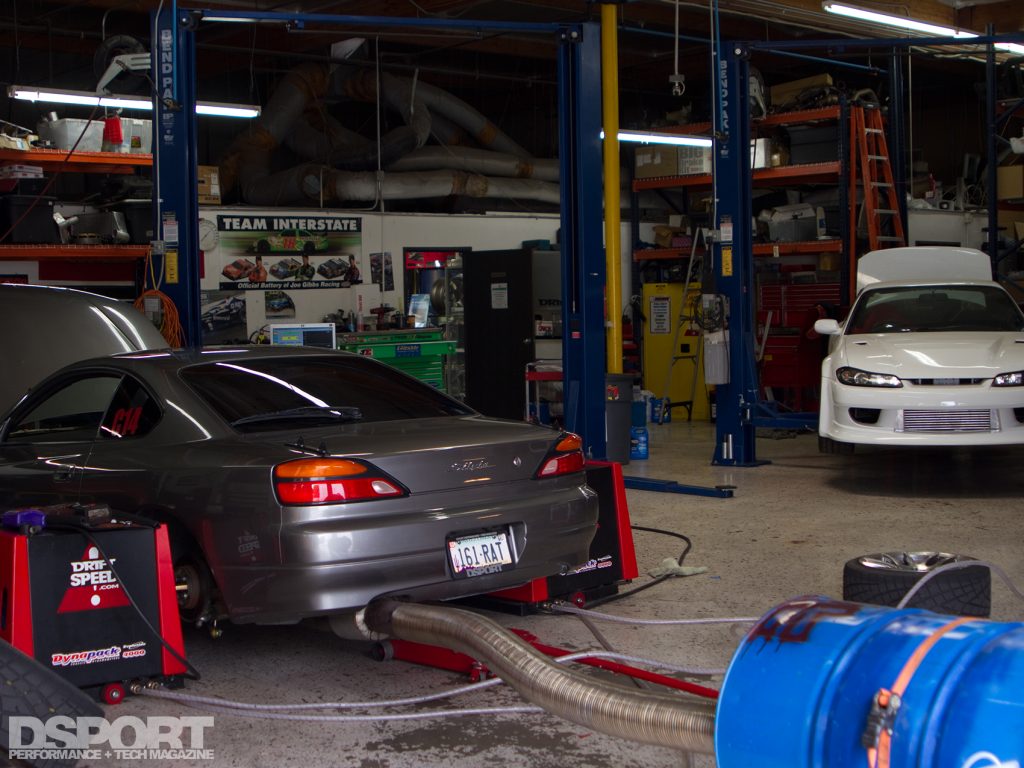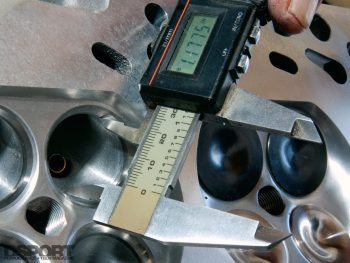 In our last SR installment of the KA vs. SR battle series (Issue #90, June 2010) we sent a brand new SR cylinder head core to TOMEI POWERED (TP) in Japan. There, TOMEI POWERED’s cylinder head specialist Mr. Tahara put the head through the TOMEI POWERED Genesis Phase One and Two cylinder head program. Phase One involved replacement of the valve seats, upgrading to Phosphorus Bronze valve guides, +1mm oversized Supertech valves, Type A valve springs and titanium retainers. Phase Two added solid lifters (to replace the hydraulic units), shims, 270-degree PROCAMS and rocker arm stoppers. Solid lifters are not adjustable, requiring Tahara-san to select the correct thickness shims instead to achieve proper valve clearance. However, converting to solid lifters reduces the chance of a rocker arm being thrown from its position between the valves and the cam lobes, allowing for a higher redline. We added TOMEI POWERED rocker arm stoppers as a further measure of insurance. For our SR, we asked Mr. Tahara to reshape and cc the combustion chambers in anticipation of a 90mm bore, which is 4mm greater than the factory SR20 bore size.
In our last SR installment of the KA vs. SR battle series (Issue #90, June 2010) we sent a brand new SR cylinder head core to TOMEI POWERED (TP) in Japan. There, TOMEI POWERED’s cylinder head specialist Mr. Tahara put the head through the TOMEI POWERED Genesis Phase One and Two cylinder head program. Phase One involved replacement of the valve seats, upgrading to Phosphorus Bronze valve guides, +1mm oversized Supertech valves, Type A valve springs and titanium retainers. Phase Two added solid lifters (to replace the hydraulic units), shims, 270-degree PROCAMS and rocker arm stoppers. Solid lifters are not adjustable, requiring Tahara-san to select the correct thickness shims instead to achieve proper valve clearance. However, converting to solid lifters reduces the chance of a rocker arm being thrown from its position between the valves and the cam lobes, allowing for a higher redline. We added TOMEI POWERED rocker arm stoppers as a further measure of insurance. For our SR, we asked Mr. Tahara to reshape and cc the combustion chambers in anticipation of a 90mm bore, which is 4mm greater than the factory SR20 bore size.
Text and Photos by Richard Fong
Go With The Flow
Once the SR head returned to America, it paid a visit to Tom Fujita at Port Flow Design to be flow tested on the Super Flow SF-600 flow bench that measured our KA24 cylinder head (see Issue #91, July 2010). Employing the same testing method as had been performed on the KA24 head, Tom measured the flow of a stock SR20 head as a baseline to compare against the TOMEI POWERED Genesis cylinder head. On the intake side, the best improvements were noted at only 0.05-inch lift, where a 26-percent improvement in flow was measured. At the maximum lift tested (0.45-inch), the gain was 8-percent. On the exhaust side, the best gain was noted at 0.40-inch lift where a 15-percent improvement was realized. At max lift, gains were on the order of 14.8-percent. These results were interesting, as TOMEI POWERED did not modify the ports dramatically. The transition from the throat to the bowl was smoothed after seating the +1mm valves, but the ports remained largely untouched. When we inquired with Allen Lorenzo of TOMEI POWERED, he commented, “We smoothed the ports and transitions between the throat and the bowl for the larger valves, but we prefer to leave as much cylinder head material as possible for the consumer, should further customization of the head become necessary.” When we compare the percentages against the KA, it would appear the SR head realized greater improvements. However, when comparing the Exhaust-to-Intake Ratios (E/I ratio – see chart), a different story is told. The SR head falls below the desired 80-percent range from 0.25 inch through maximum lift. This lower E/I ratio indicates room for improvement but also means the turbocharger may spool up more quickly, eliminating the KA24’s 97cc displacement advantage.
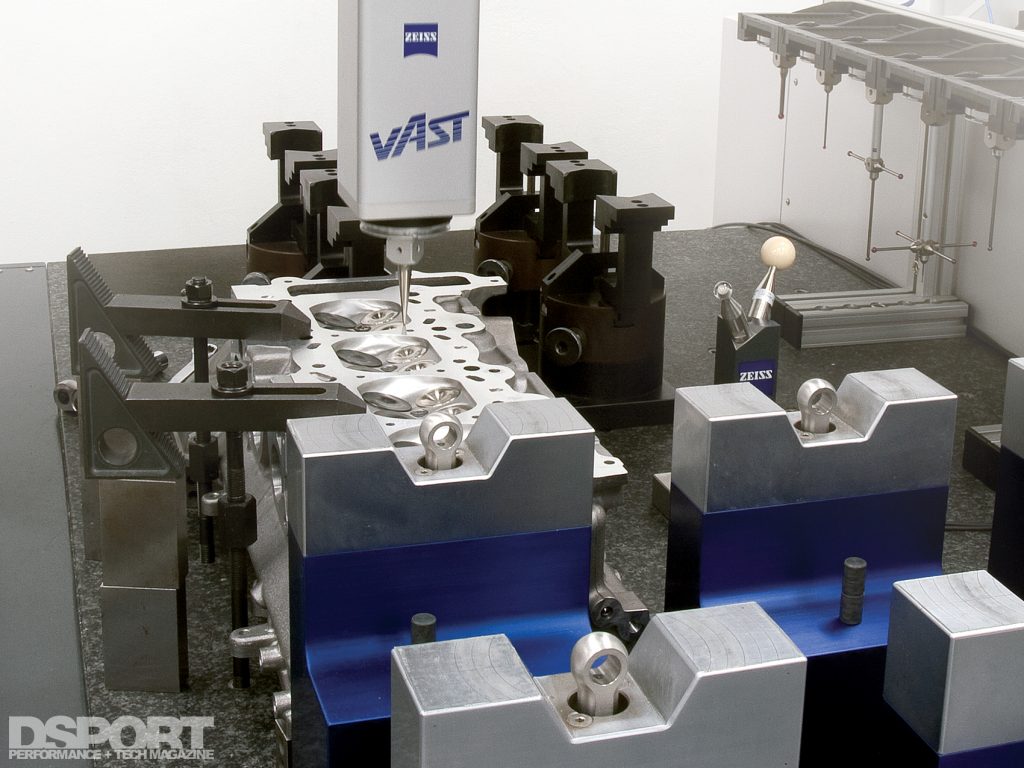 Slug Fest
Slug Fest
After flow testing, the SR20 head went to JE Pistons to be digitized. JE Pistons’ engineer Dane Kalinowski made a computer model of the SR combustion chamber using JE’s Zeiss Prismo 3D digital scanner. The scanner features an articulating probe that measures every aspect of the combustion chamber. The data can then be extrapolated into a three- dimensional model of the chamber. This process ensures precise compression ratios and a properly designed piston crown. Once the combustion chambers were digitally mapped, the data was used to create a CAD model of the custom piston. The CAD model was then uploaded to a CNC machine where forged aluminum billets were machined into custom 89.5mm pistons sporting a 9.5:1 compression ratio. These custom slugs feature the same optional thermal barrier crown and anti-friction skirt coatings as our KA24’s pistons.
3D CAD CAM software enabled JE Pistons to design custom pistons for the SR23 project.
Using Every Last Thread
Cosworth Racing developed its Ultra High-Performance Head Studs especially for the SR20. These H11 tool steel head studs were designed with a base seating feature to evenly distribute maximum load to the studs instead of the threads in the block. Says Cosworth Product Development Manager Eric Hsu, “Remember to torque our H11 tool steel head studs only to 85 lb-ft. The studs should be able to keep the block together even under higher boost levels. They can of course be preloaded to higher torque levels, but at that point you’d risk distorting the cylinder head.”
The SR20 Goes To Idaho
 While JE Pistons handled our custom piston order, the SR20 shortblock took a trip to Dan Benson Racing in Laclede, Idaho. Dan Benson has been sleeving and machining engines since 1975 and he’s no stranger to building high- power import engines. Dan resleeved the SR20 block with Benson’s Signature Sleeves and then bored the cylinders for the new JE Pistons. Since we also planned to stroke the engine, Dan line honed the main journals and clearanced the block and girdle to accommodate the 91mm TOMEI POWERED stroker crankshaft. He then blueprinted and assembled the bottom end with ACL Race Series main bearings and ARP main studs. There are different schools of thought when it comes to blueprinting an engine, and Dan presented his perspective on bearing clearances. “I like an engine that is tight. When I machine blocks and blueprint rotating assemblies, I aim for the tightest and most precise tolerances. The end result is a high-performing, free-spinning engine.” Blueprinting and machine work go hand- in-hand as much of the work depends on the application, whether it’s for drag, street or endurance and whether it is naturally aspirated or forced induction.” ACL main bearings feature three metal layers and a hardened-steel backing. ACL states that this proprietary alloy ensures the greatest relative load carrying capacity and high-RPM performance demanded of a high-performance engine. ACL bearings feature a “one-size fits all” tolerance, with an optional 0.001-inch “looser” bearing option. When Dan torqued down the ARP main studs, he used ARP’s Ultra-Torque fastener assembly lube. Unlike motor oil and other thread lubes, Ultra-Torque enables the engine builder to duplicate the torque applied to each stud with exacting precision for equal preloading. The even distribution of clamping force takes best advantage of the clamping force the ARP studs provide. The custom JE Pistons make the connection to the stroker crankshaft by way of TOMEI POWERED connecting rods and rod bearings.
While JE Pistons handled our custom piston order, the SR20 shortblock took a trip to Dan Benson Racing in Laclede, Idaho. Dan Benson has been sleeving and machining engines since 1975 and he’s no stranger to building high- power import engines. Dan resleeved the SR20 block with Benson’s Signature Sleeves and then bored the cylinders for the new JE Pistons. Since we also planned to stroke the engine, Dan line honed the main journals and clearanced the block and girdle to accommodate the 91mm TOMEI POWERED stroker crankshaft. He then blueprinted and assembled the bottom end with ACL Race Series main bearings and ARP main studs. There are different schools of thought when it comes to blueprinting an engine, and Dan presented his perspective on bearing clearances. “I like an engine that is tight. When I machine blocks and blueprint rotating assemblies, I aim for the tightest and most precise tolerances. The end result is a high-performing, free-spinning engine.” Blueprinting and machine work go hand- in-hand as much of the work depends on the application, whether it’s for drag, street or endurance and whether it is naturally aspirated or forced induction.” ACL main bearings feature three metal layers and a hardened-steel backing. ACL states that this proprietary alloy ensures the greatest relative load carrying capacity and high-RPM performance demanded of a high-performance engine. ACL bearings feature a “one-size fits all” tolerance, with an optional 0.001-inch “looser” bearing option. When Dan torqued down the ARP main studs, he used ARP’s Ultra-Torque fastener assembly lube. Unlike motor oil and other thread lubes, Ultra-Torque enables the engine builder to duplicate the torque applied to each stud with exacting precision for equal preloading. The even distribution of clamping force takes best advantage of the clamping force the ARP studs provide. The custom JE Pistons make the connection to the stroker crankshaft by way of TOMEI POWERED connecting rods and rod bearings.
Going From Short To Long
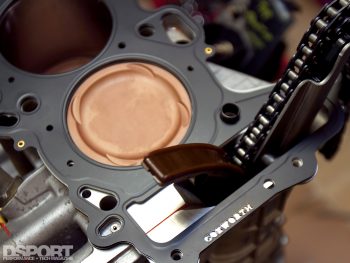 Once the completed shortblock returned from its visit with Dan Benson, it was bolted onto an engine stand and prepared for final assembly. A Cosworth 90mm head gasket was crushed between the head and the block to ensure a positive seal while Cosworth H11 tool steel head studs provide the clamping force needed to contain the increased cylinder pressures that higher power levels will produce. With all new ancillary components (pumps, pulleys, seals, etc.) installed on the longblock, the SR23 could be dropped back into the engine bay of Project Silvia. After installation, we prepared to seat the rings. Modern piston rings enjoy the benefits of technology and digital precision. When Dan Benson assembled the shortblock, he gapped the rings using a ring file and a feeler gauge to ensure precise gapping. If the gap is too tight, the ring will bind against itself once up to operating temperatures, potentially damaging itself and the cylinder walls. If it’s too loose, the rings will fail to contain the cylinder pressure and could result in excessive blow by and reduced compression. The existing tune was for a stock SR20 engine with 256-degree camshafts. The new engine is larger with longer duration camshafts. This meant that the existing tune, while capable of firing and idling, was going to run richer than the previous setup. Therefore, we utilized the A’PEXi Power FC commander to lean the injector duty cycle by a few percent, so that the initial start up would not be too rich. Doing so could “wash” the cylinder walls of lubricant, accelerating wear and potentially shortening the lifespan of the engine and its components. We fired up the engine and revved through a variety of engine speeds to get the oil pumping through the galleys and to seat the rings. After about 10 minutes, the rings were considered “seated” and we packed up and headed to Drift Speed for tuning.
Once the completed shortblock returned from its visit with Dan Benson, it was bolted onto an engine stand and prepared for final assembly. A Cosworth 90mm head gasket was crushed between the head and the block to ensure a positive seal while Cosworth H11 tool steel head studs provide the clamping force needed to contain the increased cylinder pressures that higher power levels will produce. With all new ancillary components (pumps, pulleys, seals, etc.) installed on the longblock, the SR23 could be dropped back into the engine bay of Project Silvia. After installation, we prepared to seat the rings. Modern piston rings enjoy the benefits of technology and digital precision. When Dan Benson assembled the shortblock, he gapped the rings using a ring file and a feeler gauge to ensure precise gapping. If the gap is too tight, the ring will bind against itself once up to operating temperatures, potentially damaging itself and the cylinder walls. If it’s too loose, the rings will fail to contain the cylinder pressure and could result in excessive blow by and reduced compression. The existing tune was for a stock SR20 engine with 256-degree camshafts. The new engine is larger with longer duration camshafts. This meant that the existing tune, while capable of firing and idling, was going to run richer than the previous setup. Therefore, we utilized the A’PEXi Power FC commander to lean the injector duty cycle by a few percent, so that the initial start up would not be too rich. Doing so could “wash” the cylinder walls of lubricant, accelerating wear and potentially shortening the lifespan of the engine and its components. We fired up the engine and revved through a variety of engine speeds to get the oil pumping through the galleys and to seat the rings. After about 10 minutes, the rings were considered “seated” and we packed up and headed to Drift Speed for tuning.
Always Test Fit – Cranks, Rods and Bearings
Before attempting to assemble and blueprint your block, its important to test fit the components to ensure that everything will work together. We did not anticipate that the TOMEI POWERED connecting rods would require TOMEI POWERED rod bearings. We ordered ACL rod bearings for our SR23 project, but they were 1.97mm too wide and would not fit the TP SR22 stroker crankshaft. We then ordered the appropriate bearings and the rest of the assembly went as anticipated.
Break In Or Broken
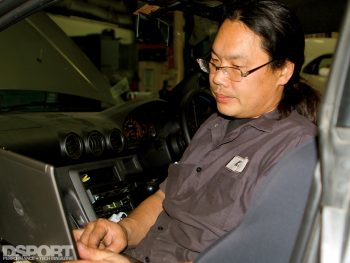 Proper break-in is an essential step in the setup of a new engine or rebuilt engine. Not doing so opens the possibility to shorter engine life, improper ring seat, bearing failure and all of the associated and undesirable side effects (loss of compression, irregularly-worn bearings, excessive blow by, etc.) Drift Speed’s resident tuner Koji Arai performed a base tune that we could employ during the break-in process. With the Dynapack dynamometer hooked up to the hubs, Koji established a conservative base tune and then began the break in process by increasing the resistance applied by the Dynapack hub pods. This load simulates driving conditions and helps with the break in of the entire rotating assembly. With regard to break in, Koji comments, “For our racecars, which we teardown and refresh regularly, 40 minutes of break in on higher power levels will produce. With all new ancillary components (pumps, pulleys, seals, etc.) installed on the longblock, the SR23 could be dropped back into the engine bay of Project Silvia. After installation, we prepared to seat the rings. Modern piston rings enjoy the benefits of technology and digital precision.
Proper break-in is an essential step in the setup of a new engine or rebuilt engine. Not doing so opens the possibility to shorter engine life, improper ring seat, bearing failure and all of the associated and undesirable side effects (loss of compression, irregularly-worn bearings, excessive blow by, etc.) Drift Speed’s resident tuner Koji Arai performed a base tune that we could employ during the break-in process. With the Dynapack dynamometer hooked up to the hubs, Koji established a conservative base tune and then began the break in process by increasing the resistance applied by the Dynapack hub pods. This load simulates driving conditions and helps with the break in of the entire rotating assembly. With regard to break in, Koji comments, “For our racecars, which we teardown and refresh regularly, 40 minutes of break in on higher power levels will produce. With all new ancillary components (pumps, pulleys, seals, etc.) installed on the longblock, the SR23 could be dropped back into the engine bay of Project Silvia. After installation, we prepared to seat the rings. Modern piston rings enjoy the benefits of technology and digital precision.
When Dan Benson assembled the shortblock, he gapped the rings using a ring file and a feeler gauge to ensure precise gapping. If the gap is too tight, the ring will bind against itself once up to operating temperatures, potentially damaging itself and the cylinder walls. If it’s too loose, the rings will fail to contain the cylinder pressure and could result in excessive blow by and reduced compression. The existing tune was for a stock SR20 engine with 256-degree camshafts. The new engine is larger with longer duration camshafts. This meant that the existing tune, while capable of firing and idling, was going to run richer than the previous setup. Therefore, we utilized the A’PEXi Power FC commander to lean the injector duty cycle by a few percent, so that the initial start up would not be too rich. Doing so could “wash” the cylinder walls of lubricant, accelerating wear and potentially shortening the lifespan of the engine and its components. We fired up the engine and revved through a variety of engine speeds to get the oil pumping through the galleys and to seat the Dynapack under load is sufficient for competition. But adding 500 street miles under varying conditions and at constantly changing speeds will ensure complete break in and optimum long-term performance for a streetcar.” After several sessions, it was time to put on some street miles. Koji kept redline below 5,000 RPM to ensure that we didn’t over rev the engine before the parts had an opportunity to break-in correctly. Keeping engine speeds under 5,000 RPM was tough, as the greater displacement engine with the TOMEI POWERED ARMS B8446 turbocharger displayed superior response that begged to be spooled up. After putting on 500- street and highway miles at a variety of speeds it was time to go back to the dyno for final tuning. Koji refined the ignition and fuel table, aiming for a steady 11.5:1 air/fuel ratio at wide-open throttle. We knew from prior testing that we had maxed out the turbocharger, therefore we didn’t expect peak power figures to rise by much. However, the 15-percent increase in displacement and the camshafts proved effective, as the horsepower curve was smoother, the power delivery shifted 500-to-800 RPM sooner and the boost spike was replaced with a more linear ramp for an additional 23.3 peak horsepower. These improvements are clearly felt as the TP ARMS B8446 turbocharger comes to life more quickly with supercharger-like response to throttle input.
DEI Titanium Turbo Shield
Heat under the hood is never good. Temperature management is not a new problem so many different solutions have been offered. DEI’s Titanium Turbo Shield presents a combination solution that features a cover for the turbine housing along with header wrap. DEI states that the Titanium Turbo Shield is capable of withstanding up to 1,800 degrees Fahrenheit of direct heat. The shield and included exhaust wrap work together to keep engine bay temperatures down while keeping the heat inside the piping for optimal exhaust gas velocity and scavenging.
On Deck: GTX Power
Project Silvia’s SR23 engine build is finally back on track. Logistics, planning and time played against the progress of the build, but it has finally come together. The next stage in preparation for battle against the KA24 is the installation of a Garrett GTX3076R turbocharger. We’ll be sending out the turbine housing and exhaust manifold to be thermal coated before we install a DEI Titanium Turbo Shield and header wrap for optimal heat management. Since we’re switching from a low-mount to a high- mount turbo manifold and a larger turbocharger, new intercooler piping becomes a necessity. We turned to Vibrant Performance for the aluminum piping and VanJen clamp assemblies needed to finish the intercooler plumbing. Once the fabrication work is completed, the Silvia will return to Drift Speed for final tuning before squaring off with Jeren’s KA-T S14 on the circuit and the drag strip.
Price List:
| ACL Main Bearings | $103.10 |
| ACL Thrust Bearings | $2.40 |
| ARP Main Studs | $165.00 |
| Cosworth Head Gasket, 90mm | $205.00 |
| Cosworth H11 Tool Steel Head Studs | $439.00 |
| Dan Benson Racing Signature Sleeves | $1,400.00 |
| Dan Benson Clearancing and Blueprinting | $1,150.00 |
| Design Engineering T25/T28 Titanium Turbo Shield Kit | $270.32 |
| JE Pistons Custom Pistons | $638.67 |
| SUPERTECH +1mm Valves (IN&EX) | $437.76 |
| TOMEI POWERED SR22 Stroker Kit With Rods | $3,490.00 |
| TOMEI POWERED Rod Bearings | $120.00 |
| TOMEI POWERED Genesis Cylinder Head Phase 1 | $4,900.00 |
| TOMEI POWERED Genesis Cylinder Head Phase 2 | $6,200.00 |
| TOMEI POWERED N2 Oil Block | $180.00 |
| Total: | $14,792.25 |
| DSPORT Street Price: | $13,313.03 |
–
Follow the KA24 vs SR20 Battle
1) SR20DET vs KA24DE | Which is Nissan’s Best Four Cylinder?
2) D’Garage Silvia | Preparing For the KA vs SR Battle
3) KA24DE vs SR20DET Act II | Preparing the KA for Boost
4) KA24DE vs SR20DET Act III | SR20DET Heads Up
5) KA24DE vs SR20DET Act IV | Port Flow Design Readies our KA24DE Head
6) KA vs. SR Battle: Act V | International SR23 – Built Right And Ready To Fight
7) SR20 Steps Forward, KA24 Gets Knocked Back | KA vs SR Update


